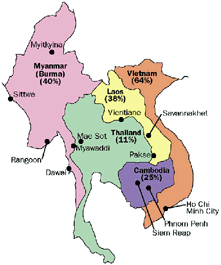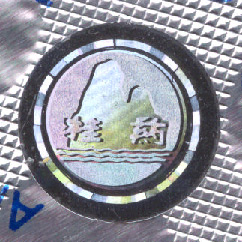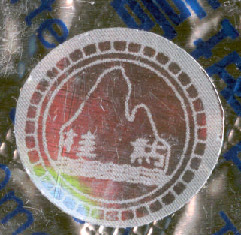Wellcome Trust 2001: Fake Artesunate In Southeast Asia
Paul Newton, Stephane Proux, Michael Green, Frank Smithuis, Jan Rozendaal, Sompol Prakongpan, Kesinee Chotivanich, Mayfong Mayxay, Sornchai Looareesuwan, Jeremy Farrar, Francois Nosten, Nicholas J White
Artesunate is a key antimalarial drug in the treatment of multidrug-resistant Plasmodium falciparum malaria in southeast Asia. We investigated the distribution of counterfeit artesunate tablets by use of the validated, simple, and inexpensive Fast Red TR dye technique. We also aimed to identify distinguishing characteristics of the fake drugs. Of 104 shop-bought "artesunate" samples from Cambodia, Laos, Myanmar (Burma), Thailand, and Vietnam, 38% did not contain artesunate. Characteristics such as cost and physical appearance of the tablets and packaging reliably predicted authenticity. The illicit trade in counterfeit antimalarials is a great threat to the lives of patients with malaria. The dye test will assist national malaria control authorities in urgently needed campaigns to stop this murderous trade.
Artesunate, in combination with slower acting antimalarials, is the recommended treatment for Plasmodium falciparum malaria in much of southeast Asia, and is pivotal in areas of multidrug resistance.1 The recent emergence of counterfeit artesunate in this region has led to the death of many patients who would have survived if given the genuine drug.2 In response, a simple, inexpensive, and reliable dye test was developed to distinguish genuine from fake artesunate. The test is based on the reaction between an alkali-decomposition product of artesunate and the diazonium salt, (Fast Red TR).3 Between August, 1999, and August, 2000, we collected samples of artesunate from shops, pharmacies, non-government organisations, and hospitals in Myanmar, Cambodia, Vietnam, Laos, and western Thailand to establish the prevalence of fakes and to identify surrogate markers of drug authenticity. We used the dye test to check for the presence of artesunate, and one observer (who was unaware of the results of the dye test) examined some of the packages for holograms, bar codes, printing, and crimping (the impression of text into foil), classifying the sample as either genuine or fake. The tablets were also examined for colour, size, weight, consistency, and taste.
|
Area / criteria |
Sensitivity |
Specificity |
NPV |
PPV |
|
|
100 85 88 75 |
73 33 97 100 |
1·00 0·78 0·95 0·93 |
0·69 0·44 0·93 1·00 |
|
|
100 100 92 83 50 |
1001·00 31 100 100 100 |
1·.00 1·00 0·95 0·91 0·77 |
0·47 1·00 1·00 1·00 |
|
|
100 100 100 |
100 100 11 |
1·00 1·00 0·41 |
1·00 1·00 1·00 |
We obtained 104 samples of blisterpacks purporting to contain artesunate tablets: 51 from Myanmar, 26 from Cambodia, 11 from Vietnam, eight from Laos, and eight from western Thailand. Most samples (95 [91%]) were labelled as manufactured by Guilin Pharma (China), or repackaged by Atlantic Pharmaceuticals (Bangkok, Thailand). Overall, 30 (29%) of the blisterpacks collected contained no artesunate. All were supposedly manufactured by Guilin Pharma—the major producer of artesunate in Asia. Of the artesunate samples bought from pharmacies and shops, 39 (38%) were counterfeit. Fakes were found in all five countries (figure). The results of examining the packaging of 84 samples gave complete agreement with the dye test.

Location and proportion
of fake artesunate samples collected
Fake artesunate tablets were superficially similar in colour, size, and inscription but were heavier than the genuine tablets (table). Genuine Guilin Pharma tablets were more friable than the fakes and had a chalky taste, whereas counterfeit artesunate tablets sometimes had a disagreeable bitter taste. In south east Asia antimalarials are traditionally bitter and chloroquine, which is largely ineffective against P falciparum prevelant in the region, may have been added to give a spurious taste of authenticity. Fakes labelled as the Guilin Pharma product were substantially cheaper than their genuine counterparts; fakes cost about 30% and 45% of the local price of the genuine artesunate in Cambodia and Myanmar, respectively. There were forged holograms on fake artesunate blisterpacks bought in Vietnam and Cambodia; those from elsewhere had no hologram. The holograms were distinctive, with a crude, hand-tooled design lacking the multicoloured, refractile appearance of the genuine Guilin holograms. Digital photographs are available from the authors. In terms of negative predictive value (ie, minimisation of false negatives), the most reliable surrogate marker of fake Guilin Pharma artesunate in southeast Asia overall was the presence of the "AS" logo on only one tablet face (table). The most reliable predictors of counterfeit artesunate in Myanmar were the lack of a Myanmar Reg number and the lack of a hologram on blisterpacks with a manufacturing date after 1998; in Cambodia, the corresponding predictors were low market price and hologram appearance.
This survey suggests that fake artesunate is a substantial public-health problem in southeast Asia. Indeed, it might even be more widespread than our results show, since some shopkeepers hide fakes from unknown buyers, especially in Cambodia where there have been publicity campaigns. Artesunate offers hope to many financially poor countries enduring problems of worsening drug-resistant malaria. However, the spread of these fakes exacerbates an already grim situation. National malaria programmes must monitor the authenticity of antimalarial drugs available through malaria programmes and directly from pharmacies, shops, and the black market. The ingredients for the artesunate testing kit cost the equivalent of about US$0.02 per tablet, compared with about $1.00 for an adult treatment course of artesunate. In the absence of the dye test, examination of the tablets and packaging can be used as surrogate markers of counterfeit artesunate - a simple approach which might be applicable to other counterfeited drugs. However, the characteristics of fakes are likely to change, as the counterfeiters respond and the ingredients of antimalarials must be monitored frequently.
The main difficulty in implementing a programme to verify antimalarial authenticity will be the logistics of testing, especially for the large quantity of artesunate sold over the counter in many small rural shops. Public education on how to detect fakes by their external appearance, as in Cambodia,2 backed by dye testing and quality assurance, could have a major impact. Prison sentences of 20 years have been given in Vietnam for trading in fake sildenafil,4 but there have been no prosecutions of fake antimalarial traders. Production is on a large scale; one organisation was delighted to buy 100 000 cheap artesunate tablets, later shown to be counterfeit. The source of these counterfeit tablets is uncertain, but our study suggests that two factories or groups of factories might be involved. The widespread distribution networks of drugs of misuse across porous borders in Asia suggest that the two sources might be linked. Vigorous, coordinated campaigns to monitor drug potency, quality assurance, education, and legal action are needed urgently.
We thank those who collected artesunate samples and helped with the analysis and advice; staff of Médecins sans Frontières-Holland (Myanmar) and Switzerland (Cambodia); the late Dr Singh, Elizabetta Leonardi-Nield, Karela Nitikorn, Mr Billion, Rose McGready, Alan Brockman, Somvang Douangdara, Nitirat Thima, Narangchai Tongyoo, Suwana Techovanich, Ajit Lalvani, and two anonymous contributors. We also thank Guilin Pharmaceuticals, Guilin, China, for their advice. This study was part of the Wellcome Trust-Mahidol University-Oxford Tropical Medicine Research Programme funded by the Wellcome Trust of Great Britain.
- Nosten F, van Vugt M, Price R, Luxemburger C, et al. Effects of artesunate mefloquine combination on incidence of Plasmodium falciparum malaria and mefloquine resistance in western Thailand: a prospective study. Lancet 2000; 356: 297–302.
- Rozendaal JA. Fake antimalaria drugs in Cambodia. Lancet 2001; 357: 890.
- Green MD, Dwight LM, Wirtz RA, White NJ. A colorimetric field method to assess the authenticity of drugs sold as the antimalarial artesunate. J Pharm Biomed Anal 2000; 24: 65–70.
- Jail for sellers of fake Viagra. Nation newspaper (Bangkok) 2000; March 31: 3
Faculty of Tropical Medicine, Mahidol University, Bangkok, Thailand (P Newton MRCP, S Proux, K Chotivanich PhD, M Mayxay MD, S Looareesuwan MD, F Nosten MD, N J White FRCP); Centre for Tropical Medicine, Nuffield Department of Clinical Medicine, John Radcliffe Hospital, Oxford, UK (P Newton, S Proux, J Farrar MRCP, F Nosten, N J White); Shoklo Malaria Research Unit, Mae Sot, Tak Province, Thailand (S Proux, F Nosten, N J White); Division of Parasitic Diseases, Centers for Disease Control and Prevention, Atlanta, GA, USA (M Green MSc); Médecins Sans Frontieres (Netherlands), Yangon, Myanmar (F Smithuis MD); Centre for Tropical Diseases, Ho Chi Minh City, Vietnam (J Farrar); European Commission/Cambodia Malaria Control Project, Phnom Penh, Cambodia (J Rozendaal PhD); and Faculty of Pharmacy, Mahidol University, Bangkok, Thailand (S Prakongpan PhD)
Correspondence to: Prof Nicholas J White, Faculty of Tropical Medicine, Mahidol University, 420/6 Rajvithi Road, Bangkok 10400, Thailand (Email: fnnjw@diamond.mahidol.ac.th)
Holograms from
Genuine and Fake Guilin Pharma Artesunate.
The holograms are ~ 9 mm diameter
 |
 |
| Genuine
Artesunate Well defined edges Rectangular middle ring segments Silver or silvery/black outer ring ‘Guilin Pharma’ legend below river |
Fake
Artesunate Poorly defined edges Square middle ring segments Grey outer ring No ‘Guilin Pharma’ legend |
Wellcome Unit,
Faculty of Tropical Medicine, Mahidol
University, 420/6 Rajvithi Rd., Bangkok
June 2001
